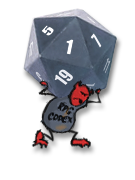- Joined
- Oct 25, 2014
- Messages
- 1,126

We know that 'Torment: Tides of Numenera' will feature a unique alignment system based on the concept of Tides. For reference, here's a description from the Kickstarter page:
There are unseen forces in the Ninth World, forces that have profound and lasting effects for those attuned to their motions. Like gravity or magnetism, the Tides are invisible, powerful, and with the right tools, perhaps controllable. The Tides represent complicated concepts that aren't entirely definable by language. Those who acknowledge the Tides have given them symbolic colors based on how they appear to correspond with emotional and psychological reactions. For example:

The colors are important, because a word like "justice" (for example) is too simplistic. The Indigo Tide represents not only justice and fairness; it might also mean a desire for the greater good or an "end justifies the means" mentality. The Gold Tide can represent false philanthropy as well as martyrdom—it's the actions that matter, not the motivations. In the game, the Tides serve as a kind of alignment system—but a more nuanced one, and one that does not judge actions based on whether they are good or evil.
As someone who's always been a bit obsessed with alignments, ideology, and psychological archetypes, I'm very enthusiastic about exploring this new system. Finally we have a truly unique and promising alternative to the outdated AD&D alignments, conventional morality, and simplistic scales of good-evil. Nietzsche would approve.
I find it interesting that two characters who would have been at opposite sides of the AD&D alignment system might have the same alignment based on this Tides system. In example, Darth Vader is arguably a prime example of Lawful Evil, and Han Solo a prime example of Chaotic Good, yet according to the Tides both would likely be Red & Silver.
Let's discuss this new system and whether it accurately covers all the complex characters we know and love. In example, I've contemplated whether there ought to be a green tide representing harmony, balance, and neutrality, but figure these are covered by the introspective blue tide.
To get the discussion started, how would you classify a character such as Tyrion Lannister? He seems to be a bit 'all over the chart', without a particularly dominating tide. Other characters that might be hard to classify would be Geralt of Rivia, and Jaheira from BG2.
There are unseen forces in the Ninth World, forces that have profound and lasting effects for those attuned to their motions. Like gravity or magnetism, the Tides are invisible, powerful, and with the right tools, perhaps controllable. The Tides represent complicated concepts that aren't entirely definable by language. Those who acknowledge the Tides have given them symbolic colors based on how they appear to correspond with emotional and psychological reactions. For example:

The colors are important, because a word like "justice" (for example) is too simplistic. The Indigo Tide represents not only justice and fairness; it might also mean a desire for the greater good or an "end justifies the means" mentality. The Gold Tide can represent false philanthropy as well as martyrdom—it's the actions that matter, not the motivations. In the game, the Tides serve as a kind of alignment system—but a more nuanced one, and one that does not judge actions based on whether they are good or evil.
As someone who's always been a bit obsessed with alignments, ideology, and psychological archetypes, I'm very enthusiastic about exploring this new system. Finally we have a truly unique and promising alternative to the outdated AD&D alignments, conventional morality, and simplistic scales of good-evil. Nietzsche would approve.
I find it interesting that two characters who would have been at opposite sides of the AD&D alignment system might have the same alignment based on this Tides system. In example, Darth Vader is arguably a prime example of Lawful Evil, and Han Solo a prime example of Chaotic Good, yet according to the Tides both would likely be Red & Silver.
Let's discuss this new system and whether it accurately covers all the complex characters we know and love. In example, I've contemplated whether there ought to be a green tide representing harmony, balance, and neutrality, but figure these are covered by the introspective blue tide.
To get the discussion started, how would you classify a character such as Tyrion Lannister? He seems to be a bit 'all over the chart', without a particularly dominating tide. Other characters that might be hard to classify would be Geralt of Rivia, and Jaheira from BG2.
Last edited:







![The Year of Incline [2014] Codex 2014](/forums/smiles/campaign_tags/campaign_incline2014.png)




















